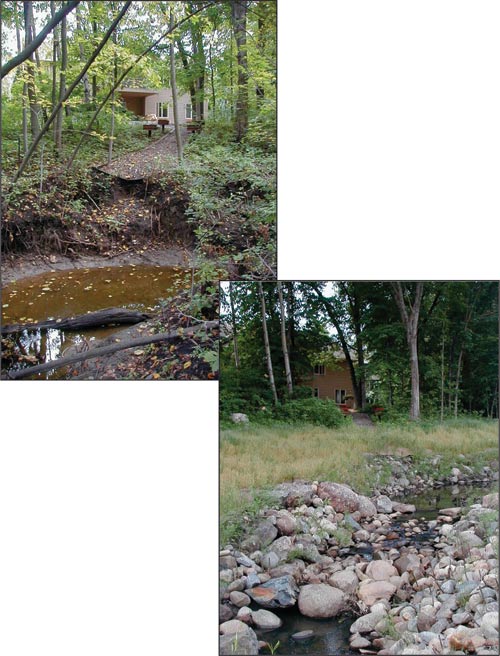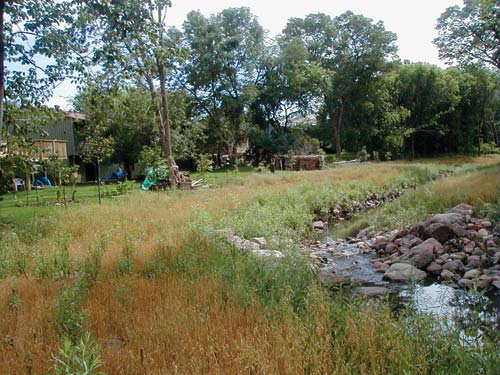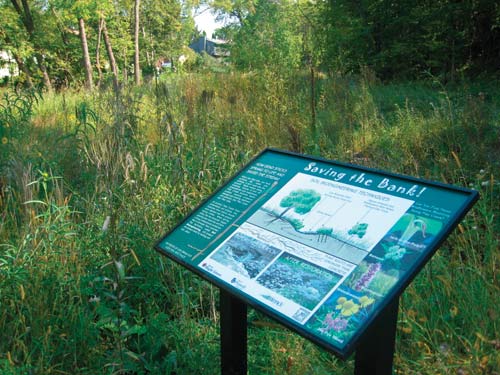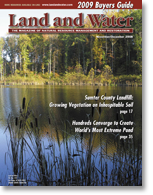Features Available Online
A Creek Without a Name Becomes a Community Asset
by L. Peter MacDonagh, RLA and Elizabeth I. Ryan, RLA

Top: Increased stormwater runoff in the watershed was causing Pike Creek to severely erode its banks, leading to property damage and poor water quality downstream. Inset: The same view as above shows the combination of hard armor and soft armor bioengineering techniques used to successfully stabilize the channel.
Welcome To Our Lake Home (and to our homes on rivers, creeks, ponds, wetlands)…
Have you ever wished that you could drink your morning coffee overlooking your own lake or river and still be at work in thirty minutes? The Twin Cities can boast of beautiful lake and riverside living, both urban and suburban, from atop the bluffs of the Mississippi River to well-loved and well-used urban lakes, like Lake Nokomis, ringed with historic homes. However, rapid development in metro areas has led to increasing stormwater volume and homeowners are witnessing the deterioration of the very features that created their quality of life. Anxious about preserving property values, they are becoming more vocal about restoration, preservation and clean water.
Suburban Development Pressure
In the Minneapolis suburbs of Maple Grove and Plymouth a group of Pike Creek area homeowners watched the rapidly eroding stream banks crumble, it seemed, before their eyes. A report by the Shingle Creek Watershed Management Commission identified channel degradation in this channel as one of the worst within the watershed, causing further concern.
Development runoff within the sub-catchment of Pike Creek had drastically altered the creek’s hydrology. Impervious surfaces of the 465 acre sub-catchment now stood at 35%-50%. Tom Schueller from the Center for Watershed Protection presented research to show that imperviousness exceeding 25% causes stream function collapse and Pike Creek was a good example of this. Also, as these neighborhoods had developed before the advent of NURP ponds, there was almost no storm water rate control. Runoff once absorbed by deep-rooted native vegetation now raced over impervious surfaces and through stormwater pipes, causing extreme fluctuations in creek water levels. Severe head-cutting of the channel bed had led to mass wasting and undercutting of Pike Creek’s banks. Consequently large quantities of sediments and pollutants washed into Pike Creek, and ultimately Pike Lake.
The land along Pike Creek is a stormwater drainage easement shared by two suburbs, common land of the Red Fox Homeowners Association on the Maple Grove side and private residences on the Plymouth side. The City of Maple Grove viewed the Pike Creek channel as an imminent problem and decided to take action, preferably with an ecological solution. The City of Maple Grove retained Wenck Associates, Inc. and the Kestrel Design Group, Inc. to lead efforts to address the problems caused by the changed hydrology of Pike Creek.
The team quickly identified the following goals: to stabilize the channel, reduce sediment inputs, increase water quality treatment and to improve the aesthetics of the creek. The site evaluation revealed a significant loss of larger trees (Box Elder, American Elm, Green Ash, Buckthorn), which allowed easier access for contractors without further potential tree damage, and gave designers more options. The US Public Land Survey from 1853 showed that early Pike Creek was a swale in an Oak Savanna landscape. Fortunately Pike Creek occurs on a Township boundary, therefore all trees, land cover, water bodies and topography were recorded in great detail. To restore to pre-settlement Oak Savanna, designers would have to re-establish an oak canopy with a light filled floor, perfect for bank stabilizing vegetation.
| The team quickly identified the following goals: to stabilize the channel, reduce sediment inputs, increase water quality treatment and to improve the aesthetics of the creek. |
Serious Site Problems
The Project Team identified the issues as:
- Major development within the 465 acre sub-catchment of Shingle Creek Watershed with limited retention and water quality treatment
- Native stream channel/swale was deeply entrenched and turned into a ditch by default
- Property encroachment/erosion impacts
- Steep channel slope or gradient
A History of Failure
Two earlier attempts to stabilize the creek had failed. The first, scattered boulders and plastic sheet piling were installed four years previously and exacerbated erosion. The second attempt, only two years before, had added rock gabions, again which failed.
Citizens were vocal in their desire for a more permanent solution to protect their Creek while sparing them the problems associated with what seemed to be ongoing construction traffic with heavy machinery and trucks to fix a problem that wasn’t getting fixed.
Designers and Engineers Meet Involved Citizens
Two public meetings held by the City of Maple Grove brought area residents from both municipalities – Maple Grove and Plymouth, into the planning process. Ed Mathieson, PE of Wenck Associates, a Water Resources Engineer, and Peter MacDonagh, RLA of the Kestrel Design Group, a Landscape Architect, fielded questions and presented the history of the area with a menu of proposed solutions. Alternatives presented included piping, hard armoring of the entire channel, and soil bioengineering. The Red Fox Cove Homeowners Association and Plymouth Residents were directly involved with selection of the project approach, tree removals, safety issues, property access, and naming of the creek.

Before: The Pike Creek channel was a mess of previously attempted and failed stabilization structures, invasive vegetation, and low diversity degraded woodland.
Alternative 1
Buried Pipe
Estimated Cost = $1,250,000
Advantages - Simple, reliable means of transporting water; Relatively maintenance-free.
Disadvantages - Will not be allowed by Minnesota Department of Natural Resources; Treats water as waste product rather than resource; Degrades Pike Lake water quality due to lack of infiltration and nutrient uptake; No aesthetic benefits, hides or buries the creek from view.
Alternative 2
Hard Armament
Estimated Cost = $575,000
Advantages - Maintains channel morphology; Proven method; Long-term solution.
Disadvantages - Discouraged by Minnesota Department of Natural Resources; Limited habitat; Increased flow velocities; May increase water fluctuations in Pike Lake.
Alternative 3
Soil Bioengineering
Estimated Cost = $650,000
Actual Cost ~ $500,000
Advantages - Rock used surgically-to provide channel bed stability, and maintain bankfull morphology on cut bank; Living, self repairing system that strengthens with age; Maximizes habitat; Enhances water quality; Field-proven method, used extensively in Europe; Protects stream banks by planting deep rooted native vegetation.
Disadvantages - Weakest at installation and needs vegetation establishment; Requires periodic vegetative maintenance.

After: The community-endorsed design solution used native vegetation and soil bioengineering techniques to restore the Pike Channel to an open canopy, savanna/prairie plant community that is now a community asset.
Public and individual property owner meetings were held to discuss the bioengineering approach. It was important to the project team that residents were aware of the major changes that would occur with the selection of the bioengineering alternative. Invasive Box Elder, Buckthorn and dying American Elms infected with Dutch Elm would be removed. Taking down trees can become a hotly contested issue if residents aren’t notified and educated about the species of trees on the site and the reason for removals. Therefore trees were tagged early in the design process (8 months before construction) between public meetings to allow residents to see potential tree impacts. The hybrid design alternative, a combination of hard and soft armor, was the least costly solution and favored the most by residents. The result of these meetings was that property owners approved and supported the selection of the bioengineering approach - an ecological design solution.
| The hybrid design alternative, a combination of hard and soft armor, was the least costly solution and favored the most by residents. |
Naming the Creek
At the start of the project, Pike Creek had no name. Residents easily settled on the choice, as the creek does flow into Pike Lake. Naming a previously un-recognized feature will elevate its status and desirability, heightening property values and fostering homeowner’s adoption of the feature.
Pike Creek Statistics
Pike Creek restoration is approximately a quarter mile in length and lies between Hemlock Lane and Pike Lake; the upper watershed area of 465 acres is almost totally developed. Stream flows range from no flow to 800 cfs. This results in a change in water surface elevation from the channel bottom to approximately 6+ feet and velocities of 8 feet per second within an hour of a storm, with water elevation receding rapidly. This combined with sheer banks was a very grave public safety condition.
- Project Length = 1,600 feet
- Project Width = <120 feet
- Max. Bank Depth = <8 feet
- Max. Water Depth = <7 feet
- Width = 10-12 feet
- Soils along channel = Hamel Loam, and Heyder Sandy Loam
- Channel gradient = 1.5%
- Flow range = 0-800 cfs
- Max. Velocity = <9 fps
Wenck Associates performed the hydrology and hydraulic analysis, as well as design of the energy drop structures. They evaluated bank full velocities and widening of the entrenched channel above bankfull. They calculated the channel forming rainfall event, also known as bankfull.
The Kestrel Design Group prepared the drawing set and detailed the bioengineering vegetation approach including species selection, live bioengineering techniques, and construction observation.

An interpretive sign illustrates the ecological concepts that were behind the successful channel stabilization.
Results
The entrenched creek channel above bankfull at point bars was widened to increase storage capacity during flood events. Rock vanes were installed for stream gradient control to stop head-cutting. Hard armor protection included root-wads and fieldstone were applied where the bank was subjected to the greatest erosive forces. Rock Gabions (rock-filled wire baskets) were considered but had failed in the previous solutions. They were substituted with rock cross vanes which worked much better with natural stream morphology.
In contrast to traditional stabilization techniques, which deteriorate and weaken with age, soil bioengineering techniques grow into a living, self-repairing system that gets stronger with age. Soil bioengineering will re-establish the oak savanna diversity prior to settlement, resulting in a deeper rhizophere, shade tree thinning, exotic species removal, and boulder toe installation on cut banks.
Rain gardens were installed in the floodplain for two reasons; to intercept hillside runoff and prevent overslope blowout, and to store water from high rain events for filtration to the ground water table.
| Rain gardens were installed in the floodplain for two reasons; to intercept hillside runoff and prevent overslope blowout, and to store water from high rain events for filtration to the ground water table. |
Monitoring Continues
Two staff-gauges and flow-meters will monitor stormwater flows into the creek to monitor water depth, channel capacity and velocities. Wenck Associates will monitor these conditions as Shingle Creek Watershed Engineers. The contractor is responsible for a two-year warranty of soil bioengineering techniques installed. The City of Maple Grove in colloboration with Fox Cove residents will provide regular control of exotic species in the future. This is based on a Management Plan provided by the Kestrel Design Group. Prescribed burns to eliminate weeds and foster the growth of deep-rooted native plants is one such maintenance tool for the banks and buffer.
Costs
Total Cost of the project was $500,000. Funding Sources were the City of Maple Grove providing 70%, City of Plymouth 25%, and Hennepin County Conservation District 5%.
Plan sheets were drawn and a bid package developed. The project was bid with an alternative of winter construction in 2001-02 or 2002-03. The least costly alternative was for construction to begin in 2002-03, which was selected.
Factors that Led to Success
Upfront citizen input was crucial in establishing project support and sharing experiences and knowledge of the creek. The project team provided flexibility with project design and the contract allowed for field adjustments. Kestrel Design Group, and Wenck Associates established a collaborative approach to their solution, with strong positive relationships among team members, the clients, and residents. Timing was a key factor, as the window of installation of soil bioengineering in Minnesota usually occurs from mid November to end of March. Once spring bud break begins soil bioengineering can’t be installed. The actual planting window for live cuttings is only about six weeks of this season, putting pressure on the design team and the contractor. Bidding for winter construction led to good bids. Winter construction with frozen ground and tracked vehicles significantly reduced soil compaction. The project was completed on schedule and under budget.![]()
For more information contact Elizabeth Ryan, Kestrel Design Group, (952)928-9600, mobile (612)730-4392, e-mail: eryan@tkdg.net, or website: www.kestreldesigngroup.com.
References:
Rosgen D. 1996. Applied River Morphology. New York: Wildland Hydrology.
Schueller T. 1993. Center for Watershed Protection, DC.
©2004 - 1998 Land and Water, Inc.

